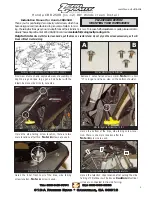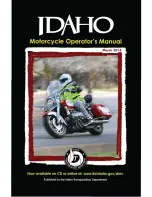
T I R E S
58
4-8
DET
AILED MAINTENANCE PR
OCEDURES
In addition to tire inflation pressure, it is very important to continuously monitor the general condition of your
vehicle’s tires.
THE FOLLOWING ITEMS ARE IMPORTANT SAFETY PROCEDURES THAT MUST BE FOLLOWED TO ENSURE
MAXIMUM TIRE SAFETY. FAILURE TO CARRY OUT THESE RECOMMENDATIONS MAY RESULT IN SEVERE
BODILY HARM.
•
Always check your tire and tread for punctures, breaks, cuts, etc. Such inspections should be done prior to
riding your vehicle each time.
•
NEVER USE DAMAGED OR REPAIRED TIRES.
Once your vehicle’s tire(s) has been compromised, it should
never be reused. It should be replaced with a new tire(s) as it is unsafe.
•
NEVER INDISCRIMINATELY REPLACE A SPENT TIRE WITH JUST ANY NEW TIRE.
New replacement tires
should be the same as the original equipment tires. (See “American IronHorse Consumable Table” for
replacement tire information.) Selection of an improper replacement tire could cause unstable vehicle
operation.
•
Always have a trained, professional service technician replace your vehicle’s tires. Special procedures and
tools are required to properly and safely install, maintain and replace tires, tubes and wheels.
•
Operating your vehicle with excessively or unevenly worn, improperly inflated or unbalanced tires can affect
vehicle stability and may result in serious injury to you and/or your vehicle.
•
Always be attentive to situations where your vehicle’s tire(s) may have been overly stressed due to striking
objects such as curbs, potholes, etc. It is possible for a tire to experience severe internal damage in such
situations without exhibiting any outward signs. Always have such tires removed and inspected, inside and
out, for possible damage before re-operating your vehicle with such tires. If ever in doubt of a tire’s suitability
for safe operation, replace it with a new tire. Never take chances on a questionable tire.
AmIronOwnerManual_body_06.qxp 5/22/2006 9:23 AM Page 58
















































